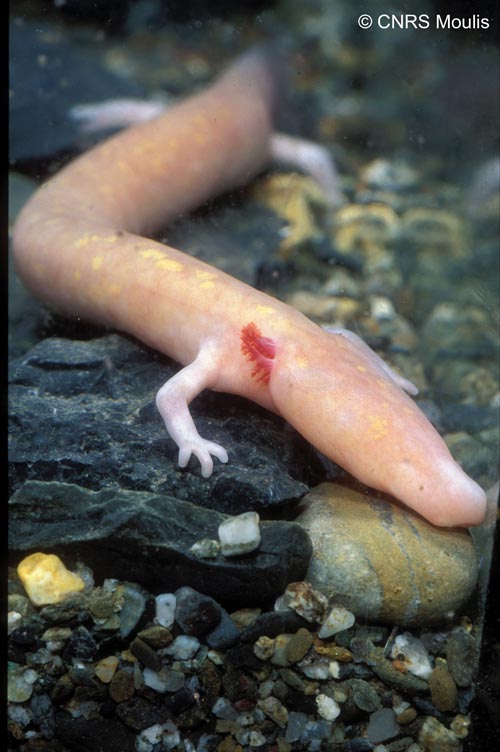

Blind cave salamander (Proteus anguinus)
Photo: Patrick Cabrol
Copyrights: Centre national de la recherche scientifique (CNRS)
Using the largest and most informative molecular phylogenetic dataset ever analysed, evolutionary biologists were able to construct a new phylogenetic tree of jawed vertebrates. This new tree resolves several key relationships that have remained controversial, including the identification of lungfishes as the closest living relatives of land vertebrates.
The evolution of jawed vertebrates is part of our own history since humans belong to the tetrapods more specifically we are mammals, or, even more specifically, primates. The study utilised a novel set of newly developed analyses for building and reconstructing, large-scale genomic datasets. In the future, this method might also be used to reconstruct the evolutionary relationships among other enigmatic groups of organisms that await resolution.
The research was done as part of a large collaborative work between several laboratories, with evolutionary biologists Dr Iker Irisarri and Professor Axel Meyer from the University of Konstanz among the principal investigators. Their research results will be published in the journal Nature Ecology & Evolution at Monday, 24 July 2017.
Fishes, amphibians, mammals, snakes, turtles, lizards, crocodiles and birds are all groups of animals that include thousands of species and are morphologically very different from each other. These animal lineages show huge differences in species richness, life history, behaviour and many other aspects of their biology. Notwithstanding these differences, they all possess a backbone and jaws.
Since their origin about 470 million years ago, jawed vertebrates have diversified extraordinarily: they include more than 68,000 described species, not counting those that went extinct. Some of them evolved key innovations that enabled their ancestors during the Devonian age to leave water and conquer terrestrial environments on all continents. They even learned to fly on more than once.
The evolution of jawed vertebrates is also part of our own history as humans. Understanding the evolutionary relationships between jawed vertebrates has thus been one of the major unsolved puzzles in biology. Despite decades of investigations, attempting to determine how some of these animal groups are related to each other has remained difficult. Estimating a robust tree that depicts evolutionary relationships is the first requirement for understanding the evolution, and also of jawed vertebrates.
Their history includes astonishing examples of repeated evolution such as flight (in birds and bats) and echolocation (bats and whales). However, such convergences can only be recognised if the relationships among organisms are estimated with confidence.
The study reconstructs a new phylogenetic tree of jawed vertebrates using the largest and most informative dataset ever analysed. A total of 7,189 genes from 100 species are employed, providing one million nucleotides each to retrace their evolutionary history. Inferring evolutionary relationships by means of statistical methods could be viewed as “molecular archaeology”, as the signals left by evolution in the DNA of our genomes are used to reconstruct events that happened millions of years ago.
The new tree of jawed vertebrates resolves several key relationships that have remained controversial despite decades of research, including the identification of lungfishes as the closest living relatives of land vertebrates, the close association of turtles with crocodilians and birds (the Archosaurs), or the relationships among amphibian groups (salamanders, frogs, caecilians) (supporting the Batrachia hypothesis).
The phylogenetic tree was time-calibrated using fossils as anchors, which allowed testing of temporal relationship of diversification with major geological events. For example, two major groups of birds and mammals had been hypothesised to have diversified as a consequence of the extinction of dinosaurs (67 million years ago). The new study invalidates this hypothesis by showing that both groups are in fact much older.
The strength of the study is a novel set of approaches for analysing new, large-scale genomic datasets. The newly developed analytical pipeline solves the most important challenges posed by the new genomic-scale data set and could thus be used to reconstruct the evolutionary relationship of other enigmatic groups of organisms that await resolution.
Original publication:
Iker Irisarri, Denis Baurain, Henner Brinkmann, Frédéric Delsuc, Jean-Yves Sire, Alexander Kupfer, Jörn Petersen, Michael Jarek, Axel Meyer, Miguel Vences and Hervé Philippe: Phylotranscriptomic consolidation of the jawed vertebrate timetree, Nature Ecology & Evolution,
To be published at: 24 July 2017
http://dx.doi.org/10.1038/s41559-017-0240-5
Facts:
• Besides Dr Iker Irisarri and Professor Axel Meyer (both University of Konstanz), participants included Professor Miguel Vences from the University of Braunschweig, Professor Hervé Philippe from the French National Center for Scientific Research CNRS, and several researchers from the German Collection of Microorganisms and Cell Cultures DMSZ, the State Museum of Natural History of Stuttgart and the Universities of Liège, Montpellier and Paris (France).
• Dr Iker Irisarri’s work as part of Professor Axel Meyer’s laboratory was funded by postdoctoral fellowships from the Alexander von Humboldt Foundation and the European Molecular Biology Organization.
• Additional funding was provided by the University of Konstanz, the German Research Foundation (DFG), the European Research Council (ERC) and the National Agency of Research of France (ANR).
Note to the editors:
You can download a photo here:
https://depot.uni-konstanz.de/cgi-bin/exchange.pl?g=ypvputb6fa
Caption: Blind cave salamander (Proteus anguinus)
Photo: Patrick Cabrol
Copyrights: Centre national de la recherche scientifique (CNRS)
Contact
University of Konstanz
Communications and Marketing
Phone: + 49 7531 88-3603
E-Mail: kum@uni-konstanz.de












